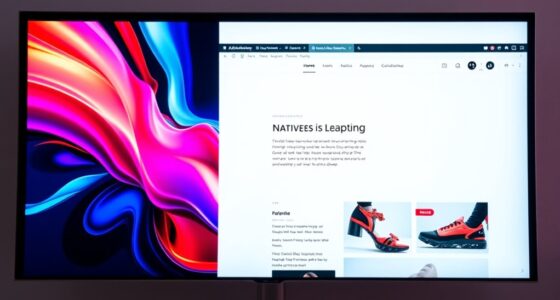To monetize your micro-niche website through affiliate marketing, focus on creating targeted, valuable content that addresses your audience’s specific needs. Use effective SEO strategies like keyword research, on-page optimization, and quality backlinks to boost your visibility. Incorporate relevant affiliate links naturally within your content and diversify income sources with ads or digital products. Continuously refine your approach based on analytics, and if you keep exploring, you’ll discover how to maximize your earnings even further.
Key Takeaways
- Conduct targeted keyword research to create content aligned with specific audience search intent.
- Integrate relevant affiliate links naturally within valuable, niche-specific content like reviews and guides.
- Optimize on-page elements (titles, headers, meta descriptions) to improve search engine visibility and rankings.
- Build quality backlinks from relevant sources to increase site authority and trustworthiness.
- Use analytics to track performance, refine strategies, and focus on high-converting content for increased revenue.

In the crowded world of online marketing, micro-niche websites have become a powerful tool for affiliate marketers looking to stand out. These small, focused websites target specific audiences with laser precision, making it easier to attract highly engaged visitors and convert them into buyers. To maximize your success, you need to develop effective SEO strategies that help your site rank higher in search engine results. By conducting keyword research tailored to your niche, you guarantee your content aligns with what your audience is searching for. Optimizing on-page elements like titles, headers, and meta descriptions, while naturally incorporating your keywords, increases your visibility. Building quality backlinks from relevant sources further boosts your authority, making it easier for your site to climb search rankings. The key is to create content that not only targets keywords but also provides genuine value, encouraging visitors to stay longer and explore more. Additionally, understanding search intent ensures your content directly addresses what users are seeking, enhancing engagement and conversion rates.
Effective SEO for micro-niche sites boosts rankings and attracts highly engaged, targeted visitors.
Once you’ve driven traffic to your micro-niche website, content monetization becomes your next priority. Affiliate marketing thrives on providing useful, targeted content that guides your audience toward products or services you promote. You might write reviews, how-to guides, or listicles that seamlessly integrate affiliate links, making it easy for readers to make purchases. The more relevant and helpful your content, the more likely visitors are to trust your recommendations and convert. To improve your content monetization, consider diversifying your income streams by including banner ads, sponsored content, or even digital products like ebooks or courses related to your niche. The goal is to create a balanced ecosystem where your content attracts traffic and encourages clicks, leading to commissions.
Consistency is vital for sustained monetization. Regularly updating your website with fresh content helps maintain your search engine rankings and keeps your audience engaged. Use analytics tools to track which pages perform best and refine your SEO strategies accordingly. Over time, you’ll learn what types of content resonate most, enabling you to fine-tune your approach and increase conversions. Remember, the effectiveness of your monetization efforts depends heavily on understanding your niche’s unique needs and preferences. By focusing on targeted SEO strategies and crafting content that genuinely helps your audience, you’ll build trust and authority—cornerstones of successful affiliate marketing.
In short, monetizing a micro-niche website through affiliate marketing hinges on smart SEO strategies and content monetization techniques. When you combine these elements with consistency and a genuine understanding of your audience, you’ll turn your small website into a reliable income source.
Frequently Asked Questions
How Do I Choose the Best Micro-Niche for Affiliate Marketing?
To choose the best micro-niche for affiliate marketing, start with thorough market research to identify underserved areas with demand. Then, perform niche validation by analyzing competition and evaluating your passion or expertise. Focus on a specific audience with clear needs, ensuring there’s enough search volume and profit potential. By doing this, you’ll find a profitable, manageable niche that aligns with your interests and offers room for growth.
What Tools Are Essential for Managing Micro-Niche Websites?
Think of managing your micro-niche website as steering a ship through calm and stormy seas. Essential tools like a content calendar keep your content on course, while keyword research acts as your compass, guiding traffic to your site. Analytics tools help you read the waves, showing what’s working and what’s not. Together, these tools guarantee you stay afloat, grow steadily, and reach your destination of affiliate success.
How Can I Increase Traffic to My Micro-Niche Site Effectively?
To increase traffic to your micro-niche site effectively, focus on content diversification to appeal to different audiences and keep your site fresh. Share your content actively on social media platforms, engaging with followers and using relevant hashtags. Collaborate with influencers or niche communities to boost visibility. Consistently optimize your site for SEO, ensuring your keywords are targeted, and monitor analytics to refine your strategies for better results.
What Are Common Mistakes to Avoid in Micro-Niche Affiliate Marketing?
You should avoid content duplication, which can drown your site in redundancy and harm your rankings. Also, don’t over-focus on an overly narrow niche, limiting your audience and growth opportunities. Picture your site as a flowing river—stagnate it with repetitive content or too strict a focus, and it will lose momentum. Instead, diversify your content thoughtfully and stay unique, keeping your audience engaged and your traffic steady.
How Do I Track and Analyze My Affiliate Marketing Performance?
To track and analyze your affiliate marketing performance, focus on conversion metrics like click-through rates and earnings. Use analytics tools to monitor traffic sources and see which channels generate the most conversions. Regularly review data, identify patterns, and adjust your strategies accordingly. This helps you understand what works best, optimize your efforts, and maximize your affiliate income effectively.
Conclusion
By focusing on a micro-niche website, you tap into a specific audience and boost your chances of success. Did you know that micro-niche sites have a 60% higher conversion rate than broader sites? This means your efforts can lead to more sales and greater revenue. So, narrow your focus, choose relevant affiliate programs, and watch your site turn targeted traffic into steady income. Micro-niche websites truly hold the potential for profitable affiliate marketing ventures.









